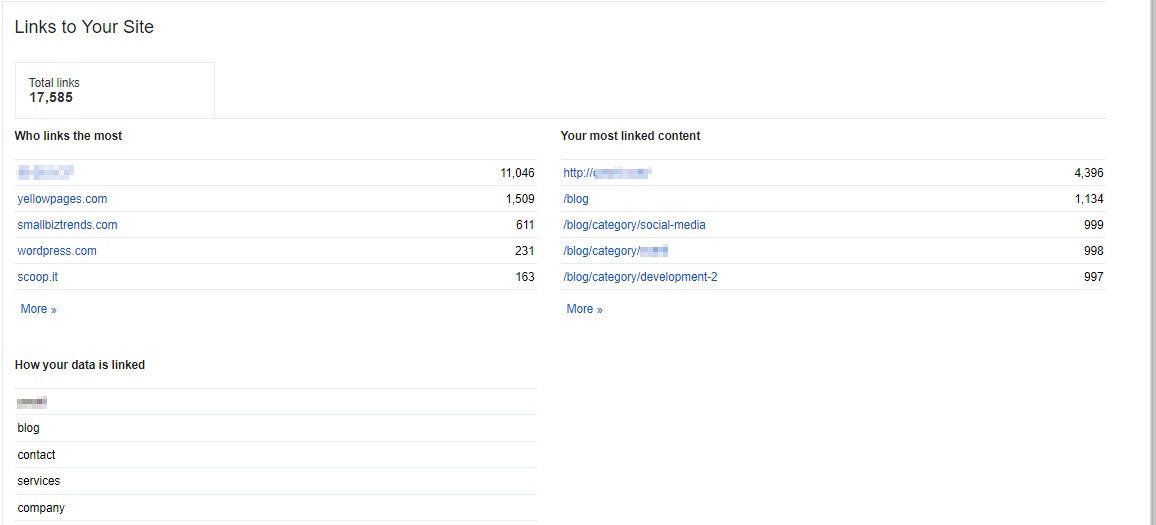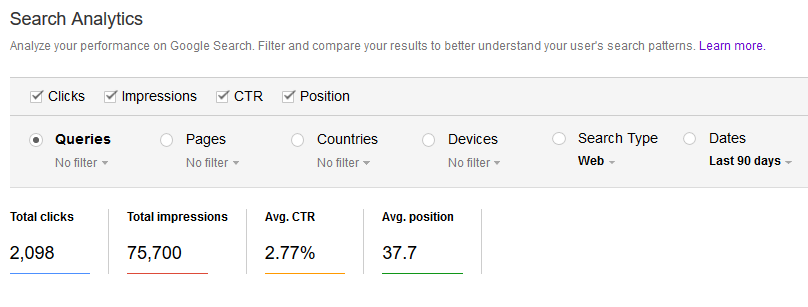Links
One of the big topics in SEO is almost always link building. Whether you’re actively building links or focusing on content creation, creating a baseline of links will help establish when and where growth occurs in a back link profile. There are several factors to consider when it comes to links in terms of quality and distribution but there are some basics that almost always apply.
Total Quantity – The total quantity of back links coming into a site is an important reference point. While this can be measured in terms of linking pages, the primary goal is to increase the overall number of referring domains. At the outset of an SEO program, look at a site’s total number of referring domains and the nature of those domains. You’ll then be able to later focus on new ones.
Where They Are Going – You’ll also want to look at where a site’s links are pointing at the outset. While most of a site’s links typically go to a homepage, it’s also important to consider how links are distributed to subpages. This is especially important if content promotion is a part of your marketing plan, as you’ll be able to better measure new links to old content.
What Is The Anchor Text – While most of your links will likely be branded, if you are measuring link growth over time, it’s helpful to know when a new referential phrase is introduced into the profile. So, if you know the scope of anchor text at the beginning of a campaign, then you’ll also be able to gauge new links with a new variation of anchor text that becomes part of the profile.
Keywords and Rankings
One of the most obvious growth signals for an effective SEO campaign is an improvement in the volume and positioning of both pages and keywords in ranking results. While some tools carry historical ranking data that can be pulled later for comparison, by creating an intentional baseline, you’ll have an initial set of numbers that can cut down on analysis time during reporting.
Total Ranking Phrases – Looking at the total scope of a site’s ranking phrases gives you a base number that will mark growth on a high level. But it’s also important to look at how the sites rankings are distributed by position. This includes the number of phrases in the top 10, top 20 and upward. Obviously in SEO, higher positions are preferable so growing the number of top ranking phrases is a marker of success.
Positions for Important Keywords – In SEO, we’re looking to move a site up in the rankings for keywords, so it’s useful to know where a site stood before work started to increase its visibility for a certain phrase or set of phrases associated with a user intent. If the site moves up in the rankings for these phrases, then that will often show in the traffic. However, being able to correlate that with position changes that show an improvement over the baseline is vital to effective reporting.
Ranking Pages – The pages that show up in a ranking report also deserve to be marked in a baseline. You’ll want to note both ranking positions and total ranking phrases. But when on-page optimization or links are part of your campaign, it’s likely you’ll see changes to the number of pages that are rankings and the number of phrases your pages rank for. So marking which pages rank, and what those rankings are, will help you establish improvement after any initiatives that are focused on those pages.
Rankings are among the most visible improvements from SEO work, and measuring progress against a baseline and correlating that with action items helps show the value of your work.
Google Analytics & Search Console
Both Google Analytics (GA) and Search Console have important overall metrics that can be used in a baseline analysis. Google Analytics maintains historical data, but Search Console does not store information beyond 90 days. So you’ll be able to go back in time for metrics in GA but Search Console information should be pulled and archived for a baseline.
Overall Organic Traffic – For a baseline, the fundamental high level metrics associated with organic traffic should be measured and recorded for later comparison. These numbers include metrics like total organic traffic volume, conversions from organic and the proportion of organic traffic compared with other channels. While you’ll be able to pull and view these numbers by comparing performance against previous time frames, it’s worth noting at the beginning and establishing a bit of history before the work begins.
Top Landing Pages – similarly you’ll be able to compare landing page performance over time, but a record of the top traffic drawing pages in organic search will help create priorities. It will also give you a specific set for comparison later that you can isolate from new pages. This allows you to develop reports to differentiate between traffic growth for existing content and new traffic resulting from new traffic.
Search Analytics in Search Console – As information in Search Console goes away every 90 days, it’s essential to record information like clicks, impressions, click-through-rate and average ranking positions as part of a baseline. Later, this information will be incredibly valuable as it shows improvements over time. Also, get Search Console Search Analytics data as it applies, not just to web search but to image and video searches as well.
These analytics are numbers that will likely be reported on a regular basis for ongoing clients, but it is always helpful to record them as a starting point to refer back to as you go through the campaign.
Conclusion
An SEO baseline report is a vital component to your ability to measure progress and show value to clients for each initiative. An effective SEO program can significantly alter the metrics associated with links, rankings and traffic and the more initial data you have, the more evident these improvements can become. Having numbers clearly established from a campaign’s point of origin will be useful each time it’s necessary to return to the beginning and show your successes, failures and create new strategies for moving forward.



